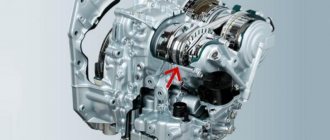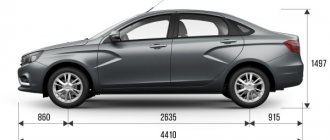Lada Largus automatic transmission is an unavailable option for the Russian station wagon, which all owners and potential buyers of this model dream of. Unfortunately, at the moment, none of the Lada Largus configurations are equipped with an automatic transmission.
But don’t rush to get upset and close the page. At the end of the article there will be very interesting and entertaining information. Now let's continue.
New Lada Largus automatic 2022 - will there be an automatic transmission?
Not long ago, photos from road tests of the Lada Largus 2021 FL appeared on the Internet. And we thought a little about the possibility of a new engine with an automatic transmission appearing under the hood. The fact is that the lenses of spy photographers caught the new Lada Largus FL from Kabardino-Balkaria.
The most interesting thing is that Lagrus was tested with a trailer, and this suggests that they were testing a new engine or gearbox, or maybe both. Otherwise, why test with additional load?
The most likely thing is that the new product will be equipped with a 1.8-liter naturally aspirated unit, which is well known to us from the LADA XRAY. However, installing a 1.8 liter engine under the hood of the Lada Largus will lead to a revision of the existing gearboxes. And here they can install either a robotic gearbox or a classic Jatco automatic. And as we know, AvtoVAZ perfectly knows how to “make friends” 1.8 with these transmissions.
There is another option - the appearance of a variator under the hood of the Largus FL, which may also require the installation of a new engine. And the most likely option would be the 1.6 H4M with 113 hp.
In any case, the appearance of the Lada Largus 2022 assault rifle is quite likely and not such a utopian possibility.
What are the features of the automatic version?
This configuration was produced not only in a 5-seater version. There was also a 7-seater option in the lineup. Everything is like Renault Logan! AvtoVAZ boldly moved along the thorny path, improving its station wagon, which made it possible to achieve maximum adaptation of the Lada Largus to domestic road conditions.
After modernization, the car began to look new, demonstrating not only a bright exterior, but also decent ergonomics in the cabin. The simplicity and conciseness inherent in the budget “Europeans” of those years did not become the very goal for the LADA Largus.
Thus, the lighting devices of the front end received improvements, which allowed the car to gain a sporty silhouette. Significant transformations affected the interior decoration, which began to compare favorably with all other models of the manufacturer. Despite the limited list of materials available for work, the designers managed to achieve a distinctive and attractive style, as well as provide the future owner with enviable comfort.
The pilot's seat has been awarded the best solutions in automotive fashion. The chair is adjustable not only for the height of the cushion, but also allows you to find the optimal position for lumbar support. The steering column has a good range of adjustments. Each driver can “adjust” the steering wheel position to their optimal preferences.
The shield is equipped with informative devices, the readings of which can be read without much concentration. Soft lighting gives the panel a special charm, which is most enthusiastically observed at night.
The on-board computer turned out to be useful, capable of presenting the driver with an unexpected surprise. It consists in the ability to read a lot of information about the current state of the car.
The pedal assembly is set up perfectly. There is no hint of the harsh pressure that the legendary “nines” or “classics” suffered from. The pedals have enviable information content, instantly forcing the car to adequately respond to the amount of pressure.
A convenient option was the ability to transform the interior. Owners are often faced with the need to transport large items that cannot fit in a standard trunk.
In special situations, you can remove some of the seats, which will allow the trunk to “grow” to an unprecedented volume.
Self-installation of the machine on Lada Largus
At the moment, nothing is impossible at all and installing a Lada Largus automatic machine is not such a difficult task. If you have free time and money, you can do anything.
The older brother of LADA Largus is Renault LOGAN, which was produced with an automatic transmission. Logan was equipped with an automatic transmission with the index DP0. This box can be installed without major modifications on a Largus station wagon with engines manufactured by Renault. But there is a significant problem - it is very difficult to find such a box for disassembly, since Logans with an automatic rifle are very rare.
What else is required to install an automatic transmission on a Lada Largus?
- Wiring from a car with automatic transmission
- Engine ECU
- Gear knob
- Interior plastic
- Transmission cushions
- Drive assembly with CV joint
- Hubs
- Flywheel
- Transmission cables
How much would such a modification cost? It all depends on the availability of contract spare parts in your city and the price tags for them. According to the most conservative estimates - from 50 thousand rubles and above. And this takes into account the fact that all work will be done independently. The problem is not in the mechanical part, but in merging the electrical parts and installing a new ECU. But, as they say, if you want, you can move mountains.
Fuel consumption
The Lada Largus car is highly appreciated by consumers not only because it is similar to the Renault Logan, but also for its fairly reasonable price. In addition, Largus is characterized by economical fuel consumption.
The modern Lada Largus is equipped with a 16-valve 1.6-liter engine. The technical specifications of the car note that when driving around the city, fuel consumption should be 12.5 liters. Operation in city conditions is characterized by the fact that the vehicle can often stand idle in long traffic jams, move at low speed among a large number of cars, wait for a long time for a green traffic light and change lanes at intersections. Under such driving conditions, fuel consumption is increased compared to driving on the highway.
Technologists at AvtoVAZ conducted research using a car with an automatic transmission and low mileage. During the tests, the car stood in a large traffic jam, and during the forced parking the air conditioner was constantly on. In such conditions, 13.3 liters of fuel were consumed. This consumption is considered acceptable for a car that is at the “break-in” stage.
If you travel when city streets are lightly congested, fuel consumption will be less by about 2 liters. However, this does not apply to those drivers who prefer to accelerate from a standstill and brake sharply. Their fuel consumption will not only not be reduced, but may even increase.
When traveling outside the city, the study was carried out on the road with a small number of stops. There were 2 traffic lights and a speed limit sign of 60 km/h on the highway. Technical conditions promise fuel consumption of approximately 7.5 liters per 100 km when traveling outside the city.
During the experiment, the average speed of the car was 76.9 km/h. Fuel consumption was 7.2 liters per 100 kilometers. The car was filled with AI-95 gasoline, which is recommended by the manufacturer. The lowest fuel consumption was when the car was moving at a speed of 100-105 km/h. This not only saves fuel, but also produces less noise in the cabin.
Lada Largus automatic transmission price
To find the price of a contract automatic transmission for a Lada Largus, we will use the drom.ru message board. We go to the parts, put the brand and model of Renault Logan, 1st generation and select the automatic transmission assembly.
As we see, almost all options are made to order from Europe. In Russia, there are practically no first Logans with automatic transmission available for analysis. The price for a contract automatic transmission starts from 35 thousand rubles and up to 45 thousand.
Story
The original station wagon based on the first Logan went into mass production in 2006, and a couple of years later the car was restyled. A descendant under the Lada brand, namely the Largus model, was presented in 2011. Largus entered mass production in 2012. The following year, the second generation Logan MCV appeared. At the same time, Largus has not yet undergone large-scale restyling, which, however, has little effect on its popularity. In 2015, Largus received a Cross modification, which the prototype does not have.
Lada Largus manual or automatic?
At the moment, Lada Largus is produced only with a manual transmission. We are talking about all modifications (station wagon, van). As well as Cross versions for 5 and 7 seats. It is impossible to buy a Lada Largus automatic from dealers.
But which is better? Undoubtedly, both automatic and manual transmissions have their advantages and disadvantages. The manual transmission is distinguished by its reliability and unpretentiousness. Servicing a manual transmission is cheaper and easier. However, an automatic is more comfortable to drive, but it cannot be towed or carried heavy loads. In the event of a breakdown, repairing an automatic transmission will be significantly more expensive. And a scheduled oil change will be many times more expensive than a manual one.
Body
Lada Largus is available in two body styles: station wagon and van. It should be noted that the first Logan had a station wagon (MCV) body, and the van was produced under the name Logan Van.
In comparison with the Logan sedan, this model received an increase in height and wheelbase by 100 and 270 mm, respectively. The length of the car is 4.45 m, width – 1.74 m, height – 1.64 m. The wheelbase is 2.9 m, the track is 1.48 m in the front and 1.47 m in the rear. That is, the car is very large for segment B.
Due to the fact that the original car was initially well adapted to local conditions, its design underwent minimal changes during adaptation. Thus, the treatment area with anti-gravel and anti-noise mastic was expanded, linings were installed on the arches and air ducts for the passenger rows of seats, and the washer fluid tank was increased to 5 liters.
The Cross modification is presented in passenger versions. Externally, it is distinguished by bumpers, arch trims and sills made of unpainted plastic, as well as black pillars.
Engine
Initially, Lada Largus was equipped with two imported Renault gasoline four-cylinder engines, including the K7M and K4M.
The K7M is an 8-valve 1.6-liter engine capable of producing up to 86 horsepower at 5,500 rpm and 128 Nm of torque at 3,000 rpm.
K4M is a 16-valve engine of the same displacement. But it is capable of developing up to 102 hp. With. at 5700 rpm and 145 Nm at 3750 rpm.
The first engine was supplied from Romania, the second from Portugal, and since 2013 it began to be assembled under license. A little later, these motors were replaced with their own analogues.
One of them was the VAZ-11189. This is an 8-valve 1.6-liter engine. Develops up to 87 hp. With. power and 140 Nm of torque at 5100 and 3800 rpm, respectively. This engine has been installed since 2015 instead of the K7M.
The second analogue was taken from a VAZ-21129. This is also a 16-valve 1.6-liter engine. Has a power of 106 hp. With. and torque of 148 Nm at 5800 and 4200 rpm, respectively. In 2022 they replaced the K4M.
Unlike Renault analogues, these engines are configured for 92-octane gasoline. It should be noted that Logan MCV and Van, in addition to the above, were equipped with two more engines: a 1.4-liter K7J and a 1.5-liter K9K diesel. However, it was decided not to use them for Largus. The Cross version is equipped only with a 16-valve engine.











